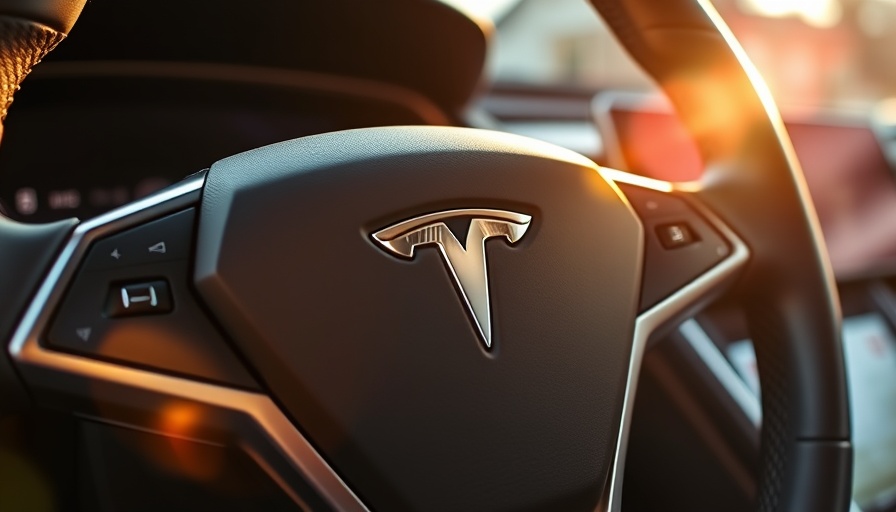
The Growing Scrutiny of Tesla's Robotaxi Plans
As Tesla gears up to launch its first robotaxi service in Austin, Texas, the excitement around this new venture is tempered by significant federal scrutiny. The National Highway Traffic Safety Administration (NHTSA) has recently initiated an investigation into Tesla's advanced driving software, known as Full Self-Driving (FSD) Supervised. This investigation arises from concerns about how well this technology performs under less-than-ideal visibility conditions, which is critical for the safety of both passengers and pedestrians.
Understanding the Federal Investigation
The NHTSA's Office of Defects Investigation is delving into Tesla's FSD capabilities, particularly focusing on the ability of these vehicles to operate safely in various environmental challenges like sun glare, fog, rain, or snow. The agency's investigation was sparked by multiple reported crashes involving Tesla vehicles when visibility was compromised. Investigators have sent a detailed list of inquiries to Tesla, asking for insights into their evaluation processes and safety measures for the upcoming robotaxi service set to launch this June.
The Implications of Full Self-Driving Technology
Tesla's robotaxi initiative is exciting but represents a significant leap in technological innovation, raising questions around public safety and regulatory measures. Currently, Tesla's FSD Supervised program requires drivers to stay alert and maintain physical control of their vehicles, even while the software assists in driving. The company's plan to transition to an 'unsupervised' version of FSD for its robotaxi fleet raises additional concerns regarding the level of safety and oversight.
What We Know About Tesla's Operational Plans
Out of the blue, Tesla's May announcement via social media about the early launch of their FSD service caught the eye of federal regulators. The post outlined the company's completion of over 1.5k trips and about 15,000 miles of driving across Austin and San Francisco, aiming to develop and validate its operational software. However, the letter from NHTSA emphasizes the need to evaluate whether the forthcoming robotaxi system would perform comparably to the supervised version of FSD.
The Stakes of Autonomous Vehicles
The stakes of introducing a fully operational robotaxi service are incredibly high. Not only does it represent a new chapter for Tesla, but it also sets a precedent for the autonomous vehicle industry as a whole. Public perception and trust are crucial for the acceptance of such technology, and negative incidents could derail the advancement of autonomous ride-sharing services. The questions posed by the NHTSA highlight the ongoing debate about the stringency of regulations needed to ensure public safety.
Future Predictions for Autonomous Ride-Sharing
Looking forward, the outcomes of this investigation could steer the trajectory of not just Tesla but also other companies venturing into the autonomous vehicle domain. Insights drawn from these regulatory actions could lead to stricter guidelines for the deployment of self-driving technologies, impacting the overall pace of innovation within the sector. With electric and autonomous vehicle technologies rapidly evolving, only time will tell how regulations adapt to keep pace with advancements.
Public Perception: Balancing Innovation with Safety
As Tesla moves forward with projects like the robotaxi service, public sentiment will undoubtedly play a vital role in the success or failure of these initiatives. Many consumers are excited about the convenience and efficiency of ride-sharing services powered by cutting-edge technology. However, concerns related to safety cannot be overlooked. The automation of driving functions raises ethical questions and anxieties about reliability and accountability.
What This Means for Tesla and its Competitors
Tesla's competition in the self-driving space must monitor these developments closely; the scrutiny brought upon Tesla's operations can have implications for their own autonomous ventures. Companies like Waymo and Cruise are also expanding their autonomous ride-sharing services and will need to navigate the challenges that come with public acceptance and government regulation. As the industry evolves, companies will need to focus on developing technology that not only leads in innovation but also instills confidence in the safety and reliability of their vehicles.
Conclusion: Navigating the Road Ahead
As Tesla anticipates a major expansion into robotaxi services, they standing at a critical junction between technological innovation and regulatory oversight. The unfolding story will not only impact Tesla but could reshape the future of transportation in a substantial way. It’s essential for consumers, stakeholders, and regulators alike to collaborate to develop a framework that prioritizes safety while allowing technology to flourish.
 Add Row
Add Row  Add
Add 



Write A Comment